Are you a Quiet Speculation member?
If not, now is a perfect time to join up! Our powerful tools, breaking-news analysis, and exclusive Discord channel will make sure you stay up to date and ahead of the curve.
A while ago I asked the forums for cards to discuss in my articles. Getting There Games suggested looking at alternate win conditions and I immediately felt that those would likely make a great article on their own. As I look back on writing this article, I believe they do an excellent job of showcasing how to analyze a specific set of cards to look for patterns.
Defining Alternate Win Conditions
What do we mean by an alternate win condition? It may seem like this is an easily answerable question, but do you count poison-based wins or cards that cause a draw? Are milling wins rare enough to be considered an alternate?
For our purposes today, I am counting single cards that either contain text like "you win the game," or something akin to "your opponent loses the game." The latter doesn't actually appear on cards verbatim, but Door to Nothingness comes close.
I have taken the liberty of creating a chart with the buylist price graphs of all of these cards that I could find, figuring that buylist prices are a little less prone to sudden swings. The price is the non-foil average if there are multiple printings. None of the cards have particularly rare or valuable older printings that skew the numbers, though I did start the data in January 2013 to keep Vraska the Unseen's very high initial price from skewing the graph.
Kelly has been kind enough to give me direct access to the Trader Tools data, from which I hacked something together—unfortunately you cannot create a similar overview yourself. I cannot say whether any of this will ever be implemented in TT, but I wouldn't recommend holding your breath.
If you wanted, you could do the same analysis by looking at the graphs of individual cards—as you can see by the messiness of the graph below, for a larger number of cards that may actually be preferable.
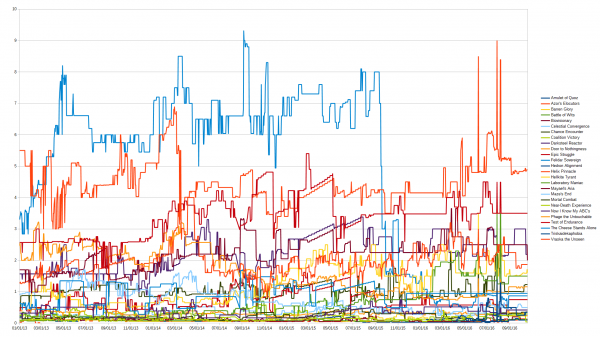
Casual Analysis
In an earlier article, I laid out my criteria for evaluating a card's casual appeal. Let's take a look at how these alternate win conditions stack up overall for casual play.
- WOW! Factor: Even when you're completely down on your luck you can still win; they'll never see it coming!
- Playability: These are usually found in decks built around them specifically, as being able to take advantage of them is seen as a fun challenge. Still, many are a bit tougher to get into play.
- Scalability: "You win the game" scales perfectly; on the other hand, "they lose" cards take a bit more effort to pull off in a multiplayer game.
- Taste: Having one of these in play and being able to trigger it is like the ultimate reach: no blocker can stop it. Some players like the challenge of getting the weirder ones to trigger. Others like to add them to decks where they slot in well and randomly win with them every now and then. Some of these cards likely get played for their other abilities. Finally, there are people who just want to do something different and who have taken a particular liking to one of them (whether challenging or not).
I don't really like any of these for casual, but I can't deny that they have their fans. Personally I feel that they all have the capacity to end a fun game prematurely, thereby ruining the experience for the remaining players because everything they did before was pretty much irrelevant. For one-on-one this is not a big problem—you have to win in some way or another—but in multiplayer it may well feel like stealing a win from those more deserving, especially when it happens after a long battle.
I imagine that the people who like these cards fall in the groups described under "Taste" above, and that there are enough of them to generate sufficient demand. To make sense of this, we'll need to dig deeper.
Financial Analysis
As the first graph is a bit hard to read, I want to pull the data apart to see if we can find patterns in the popular and unpopular cards. The graph below shows all the cards that hit a buylist price of $5 or more at some point since 2013.
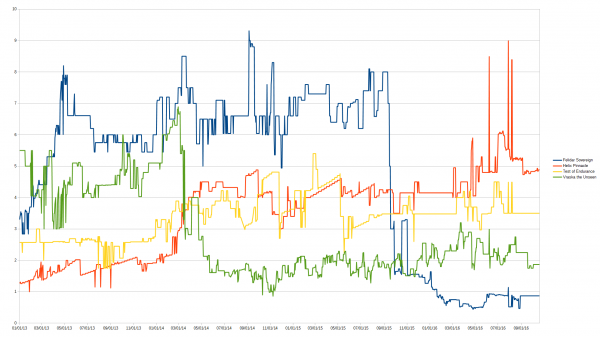
We can see a few things here. Currently only a single alternate win condition card buylists for more than $5 (Helix Pinnacle). Felidar Sovereign and Vraska the Unseen were putting up a good fight until their most recent reprint. Test of Endurance only barely made this chart.
The first lessons to learn from this data are that reprints are pretty bad for these cards, and that $5 is a pretty hard barrier to break.
So we have to wonder, why is the Pinnacle so much higher than the rest? As a card from Eventide, a notoriously underprinted set, it would be expected to sit a little higher naturally. Add to that that the card costs very little to cast, has shroud to prevent opponents from answering it, and asks you to do something its color is very good at, and we seem to have a perfect storm on our hands.
By similar reasoning, we can explain that Test of Endurance sits a bit higher too. It's pretty old, and one of the easier-to-trigger alternate win conditions (it's even likely to go into the same decks as Felidar Sovereign, and we know how popular that used to be).
Given what we've learned, lets look at all the alternate win condition cards that have been reprinted.
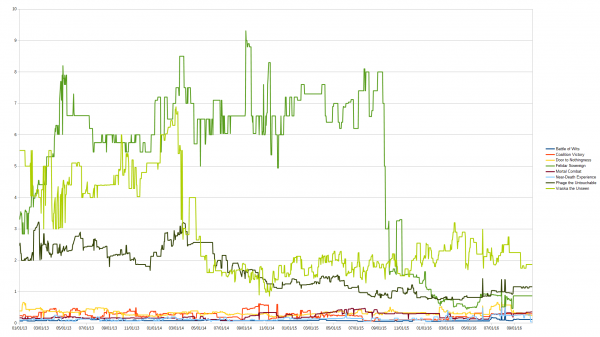
We see that Phage the Untouchable behaved the same as the cards we just identified, and this was after its third reprint—it sat even higher before that happened. The other reprints are all sitting pretty low, with none of them breaking $1.
In fact, the Sovereign dropped below $1 due to its recent reprint and Phage brings in barely more than that. The data doesn't go back far enough, but I remember Battle of Wits being a $5-plus card long ago, and I believe that reprints killed its value too.
Of all these cards, Vraska sits the highest. I believe this is because of a combination of its mythic rarity, Duel Decks mostly being an entry-level product that's printed in lower volumes, and the card having extra uses beyond creating deadly assassins.
Lets also look at underprinted cards. These should include old sets, third sets and Un-sets while of course ruling out anything that was reprinted.
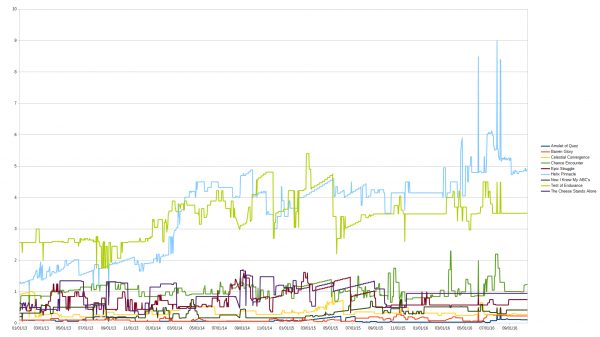
We've seen Helix Pinnacle and Test of Endurance before; the rest barely gets above $1. Clearly, being underprinted by itself is not a good indicator of value, but rarity and playability together can lead to value.
I believe that the cards closer to $1 have the possibility of moving up when something gets printed that increases interest in them. In particular Chance Encounter and Epic Struggle look interesting to me, as they are fairly easy to trigger already—though if you have so much luck or so many creatures: do you really need them to win? I wouldn't go out of my way to pick them up, but if I was holding some I probably wouldn't buylist them either.
It's clear that it's difficult for these cards to go above $1. Let's list all the ones we haven't already discussed that reached $1.5 or higher and see if we can figure out what pushed them up.
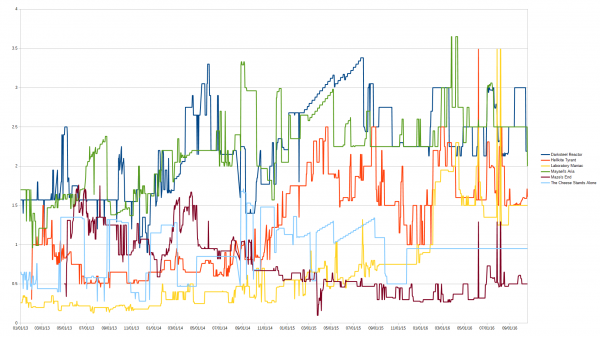
- Darksteel Reactor - The Reactor is colorless, making it fit in many decks. Darksteel probably wasn't printed to nearly the numbers we see today, so rarity may be a factor. Charge counters can be manipulated fairly easily by several cards from the same block. As it's indestructible, the card is very hard to get rid of. If we look at TCG Player's "also purchased," we see Coretapper and a number of other cards which benefit from counters, though there doesn't seem to be a clear deck archetype being bought.
- Hellkite Tyrant - Dragons are always popular and this one is mythic to boot. His stealing effect is useful in any case, and note that you don't have to give them back when he dies. In fact, I think his alternate win condition is often an afterthought, as a 6/5 flying trampler should do well at killing opponents anyway. If we look at TCG Player again, we mostly see other Dragons, suggesting that this indeed tends to go in Dragon decks.
- Laboratory Maniac - It's considered general knowledge that casual players like milling. From there it's not a big step to milling yourself as a more original approach to it. This card is a bit of a combo enabler as well, and it even sees some Legacy and Modern play. I would argue that tournament interest is a relevant factor for this card, and that together with casual interest it is pushing up the card's price despite it being newer. Note how Maniac started the lowest of this bunch—it is definitely the kind of card you should be on the lookout for. I don't think TCG Player tells us much extra in this case.
- Mayael's Aria - The Aria provides some very beneficial effects before winning you the game. I think it's comparable to the Hellkite in that you may very well play it for its other uses, and when we look at TCG Player we see some overlap in the other cards purchased for both of these cards. It's in a good color combination for its sort of effect, and I would look for similar cards from future sets as they may prove to be good to hold for several years.
- Maze's End - The prerelease printing is probably suppressing this one to some extent, and it's also somewhat hard to trigger. We can clearly see that its popularity dwindled a bit after initial hype, but now it's slowly recovering. This seems like a card that might slowly creep up, and as it refers to Gates specifically it's not easily reprinted. I would recommend holding or even picking up a few extra. TCG Player tells us it's always bought with Gates—what a surprise.
- The Cheese Stands Alone - Unglued is starting to become a more rare set, and due to its nature it probably wasn't opened much in the first place. There are likely very few people looking to play it, but not many would be needed either. This is usually bought with other Unglued cards that seem to have no other connection to it, perhaps suggesting that at least part of its value comes from collectors completing sets.
Finally we should look at anything that's left, as it's equally important to figure out why the duds failed to reach a higher value.
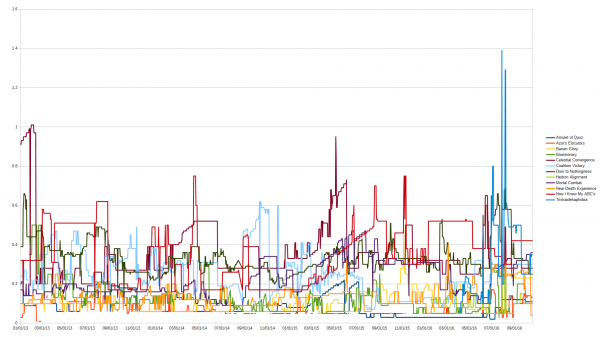
- Amulet of Quoz - Due to its ante reference this card is clearly unplayable. While I have casually played for ante before, it was never with constructed decks. I'm sure there's someone somewhere playing it, but there just aren't enough of those people around.
- Azor's Elocutors - Fairly new printing, and you have to do a very boring thing to win: make sure you don't get damaged. I just can't see anybody getting too excited by this.
- Barren Glory - A challenging condition that leaves you very vulnerable. This is fun for the most die-hard Johnnies, so there is some demand.
- Biovisionary - Fairly new, but fairly easy to trigger. Does require two specific colors. I imagine this might eventually start rising when demand from a growing player base becomes sufficient. Perhaps set them aside when they come in with bulk.
- Celestial Convergence - Waiting for seven turns is a lot, and even after that you still aren't guaranteed to win. Difficulty versus fun probably just doesn't balance out well.
- Coalition Victory - I believe this would sit higher if it wasn't both reprinted and banned in Commander. This would probably see an increase if it was ever unbanned, but I wouldn't count on that happening. As it stands, this is one of the better low-value cards as can be seen by its buy price bouncing around a little. I think it gives a player an interesting challenge while not completely forcing a certain deck type.
- Door to Nothingness - Comparable to Coalition Victory in many ways and showing similar price behavior. Reprints probably killed this one as a spec too.
- Hedron Alignment - These come in as bulk all the time. Like some of the popular ones, it protects itself, has a useful ability that lets you find the other copies or stuff to protect it, and it's not too difficult to cast. I would definitely consider picking these out of bulk, but realize that it might take many years before they slowly start increasing.
- Mortal Combat - You have to wonder if you couldn't have won the game in another way with those 20 creatures. This is another card where milling yourself might be part of the strategy. I notice that recently it has seen some price movement, and of course its reprint happened long ago. I suppose this may very slowly slide upwards over time, though I would place my bets elsewhere unless you consider it likely that a card that breaks it will be printed. I believe if that was going to happen it already would have.
- Near-Death Experience - Being at one life is a very precarious position, as you'll die to just about anything. The card has a pretty strict color requirement, suggesting a two-color deck at most and probably mono-white. Compared to other alternate win conditions in white, it seems weaker than the ones that gain you life (and therefore protect you in the process), and if you wanted a true challenge then Barren Glory seems more interesting.
- Now I Know My ABC's - I see a few Unhinged cards in the "other cards purchased" for this card, so I am guessing that again some of this demand is based on collectors. On the other hand, there are some other cards in there too so I do think some people actually try to play it. I suppose we're seeing some rarity influence as well. I don't think there's much to see here otherwise.
- Triskaidekaphobia - Our newest addition. Flavorwise this card is great. It's not the most challenging to trigger, though not particularly easy either. It's definitely difficult enough to discourage tournament play. The amount printed will likely keep this card down for a long time. I imagine this will ultimately behave similar to Hidetsugu's Second Rite as that also requires a specific amount of life—a card worth only slightly more than bulk.
Summary
- Stay very far away when an alternate win condition gets reprinted!
- The cards that seem to do best are the rarer ones that are easy to trigger.
- Don't discount cards that do more than just winning you the game, as they may see play because of their other abilities.
- Feel free to ignore cards that seem particularly challenging to trigger or that seem boring.
- Never bother with ante.


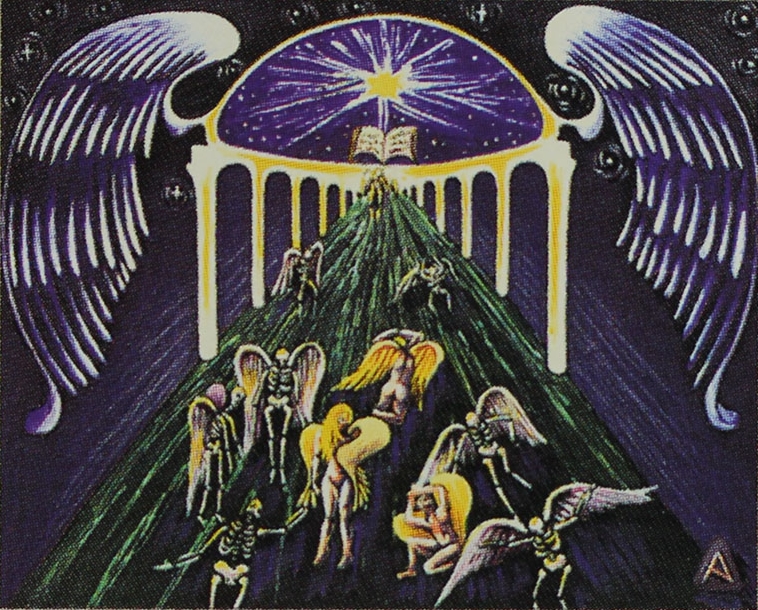


This was an interesting piece, and very unique subject matter. I think the core audience for these types of cards will find this very informative. Thanks for sharing!
Thanks Tarkan!
Funnily I doubt the core audience for these types of cards cards will ever get to read this article because it’s on QS Insider, however, my aim is not to reach them but to help fellow MTG Finance people understand what makes them tick. I also wanted to show how to do analysis on a group of cards as I don’t think that’s often been covered (especially not on less common groupings such as this, I’m sure someone has looked at Duals or Fetches for example). My general aim is to teach.